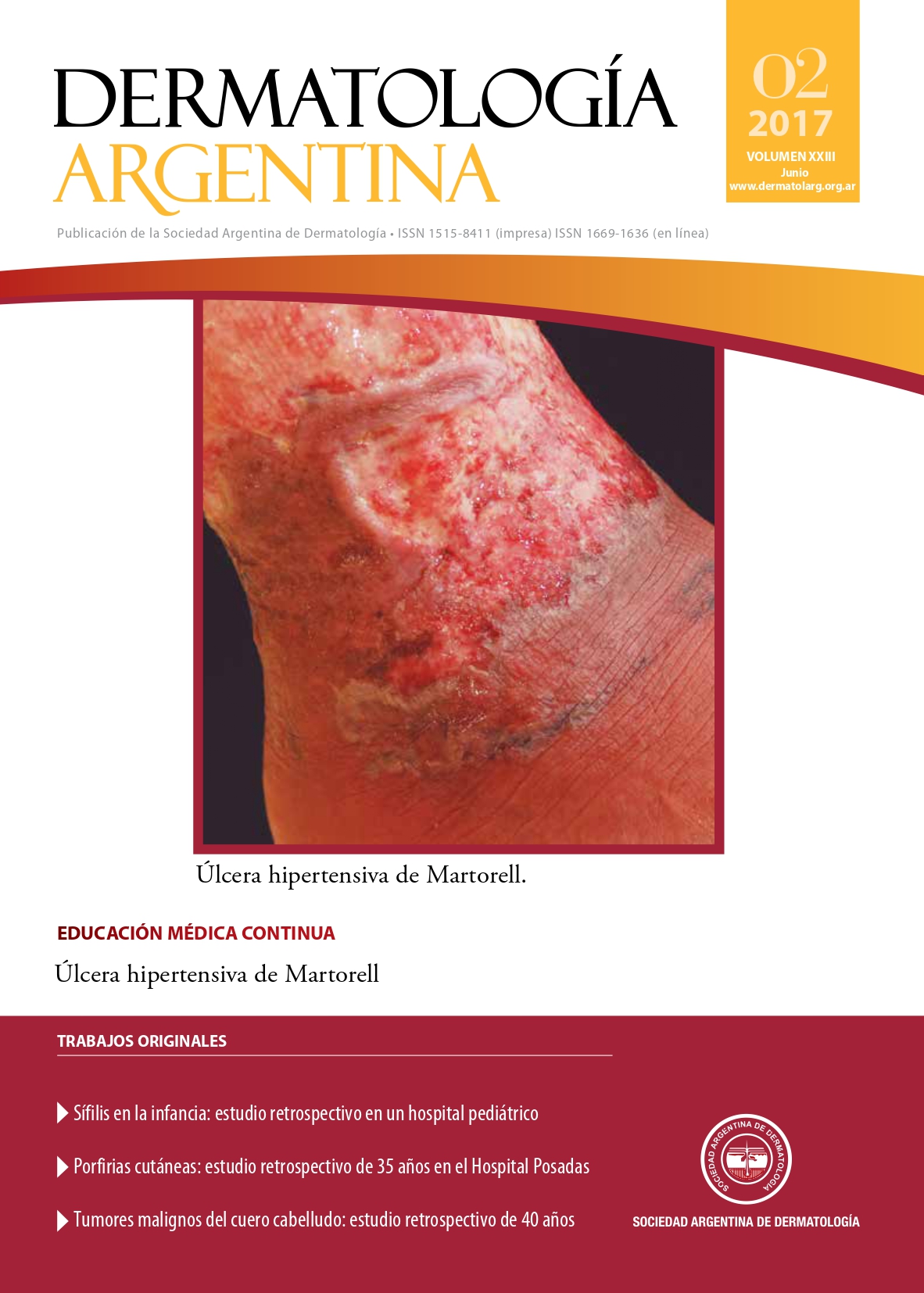Angiolymphoid hyperplasia with eosinophilia
Keywords:
ALHE, eosinophilia, angiolymphoid hyperplasiaAbstract
Angiolymphoid hyperplasia with eosinophilia (ALHE) is a benign rare disease which features angiomatous solitary or multiple lesions usually located on the scalp and face of young adult patients and rarely, on the submucosa or oral mucosa. Clinically it manifests as papules or nodules of well-defined vascular appearance sometimes with ulcerations or covered with blood crust. They are usually asymptomatic but in some cases they may have itchiness or tenderness and its treatment is conventional surgery with tendency to recurrence. The finding of clonality in some cases raises many questions regarding its etiopathogenity.
References
I. Wells GC, Whimster IW. Subcutaneous angiolymphoid hyper-plasia with eosinophilia. Br J Dermatol 1969;81:1-15.
II. Driban N, Parra V, Bassotti A, Pizzi de Parra N. Hiperplasia an-giolinfoide con eosinofilia. Presentación de tres casos y revi-sión de la literatura. Rev Argent Dermatol 2001;82:180-187.
III. Abrahamson TG, Davis DA. Angiolymphoid hyperplasia with eosinophilia responsive to pulsed dye laser. J Am Acad Derma-tol 2003;49:195-196.
IV. Olsen TG, Helwing EB. Angiolymphoid hyperplasia with eosi-nophilia, a clinicopathologic study of 116 patients. J Am Acad Dermatol 1985;12:781-796.
V. Quattrocchi CM, Jankovic R, Jacquier M, Sánchez A, et ál. Hi-perplasia angiolinfoide con eosinofilia: reporte de un caso. Arch Argent Dermatol 2012;62:189-192.
VI. Zhang GY, Jiang J, Lin T, Wang QQ. Disseminated angiolym-phoid hyperplasia with eosinophilia: a case report. Cutis 2003;72:323-326.
VII. Arias M, La Forgia M, Retamar R, Buonsante ME, et ál. Hiperpla-sia angiolinfoide con eosinofilia. Comunicación de 4 casos, 3 tratados con láser. Rev Argent Dermatol 2007;8:329-335.
VIII. Berney DM, Griffiths MP, Brown CL. Angiolymphoid hyperpla-sia with eosinophilia in the colon: a novel cause of rectal blee-ding. J Clin Pathol 1997;50:611-613.
IX. Guinovart RM, Bassas-Vila J, Morell L, Ferrándiz C. Hiperplasia angiolinfoide con eosinofilia. Estudio clínico patológico de 9 casos. Actas Dermosifiliogr 2014;105:e1-e6.
X. Zarrin-Khameh N, Spoden JE, Tran RM. Angiolymphoid hyperplasia with eosinophilia associated with pregnancy: a case report and review of the literature. Arch Pathol Lab Med2005;129:1168-1171.
Downloads
Published
Issue
Section
License
Copyright (c) 2017 Argentine Society of Dermatology

This work is licensed under a Creative Commons Attribution-NonCommercial-NoDerivatives 4.0 International License.
El/los autor/es tranfieren todos los derechos de autor del manuscrito arriba mencionado a Dermatología Argentina en el caso de que el trabajo sea publicado. El/los autor/es declaran que el artículo es original, que no infringe ningún derecho de propiedad intelectual u otros derechos de terceros, que no se encuentra bajo consideración de otra revista y que no ha sido previamente publicado.
Le solicitamos haga click aquí para imprimir, firmar y enviar por correo postal la transferencia de los derechos de autor












